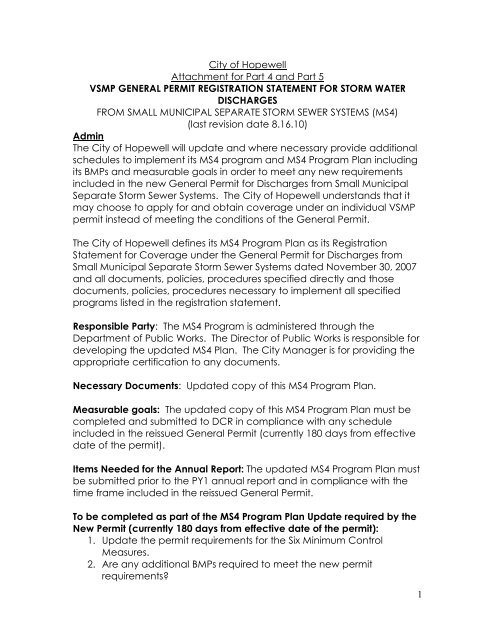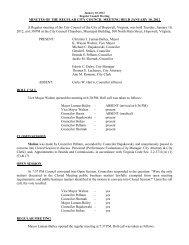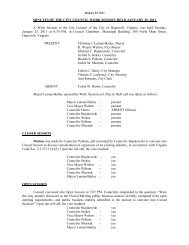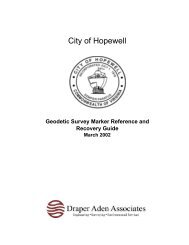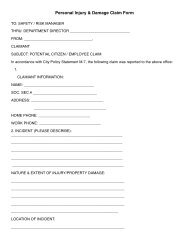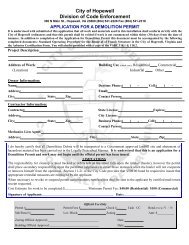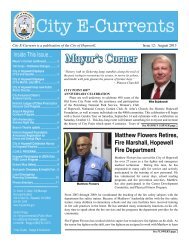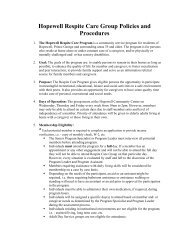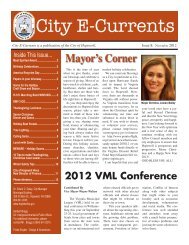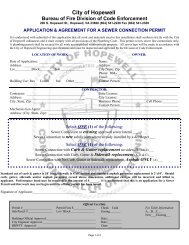VSMP-General-Permit - City of Hopewell, Virginia
VSMP-General-Permit - City of Hopewell, Virginia
VSMP-General-Permit - City of Hopewell, Virginia
You also want an ePaper? Increase the reach of your titles
YUMPU automatically turns print PDFs into web optimized ePapers that Google loves.
the Public. We will provide the <strong>City</strong> booth with stormwater information fordistribution at this event.Responsible Party: The Public Works Services Manager is responsible forgathering and maintaining a supply <strong>of</strong> information available. In mostcases the information can be given to the <strong>City</strong> Public Information Officerfor distribution at Public meetings, otherwise the Public Works ServiceManager will ensure that “handouts” are available at these meetings.Necessary Documents: The informational handouts containingstormwater information. Again, Updated information handouts on thesubjects <strong>of</strong> Land Development and Storm Water Managementrequirements are available at pubic information stations outside theOffice <strong>of</strong> the <strong>City</strong> Engineer and the Department <strong>of</strong> Development bothlocated on the 3 rd floor <strong>of</strong> <strong>City</strong> HallMeasurable goals: The number <strong>of</strong> meetings where stormwaterinformation is available to the Public. Quantity <strong>of</strong> handouts distributedduring the Public meetings/events.Items to be reported in the Annual Report: Copies <strong>of</strong> the informationalhandout and quantity distributed on an annual basis.Modifications per required Admin Update: TSDMinimum Control Measure: Public Education and Outreach on StormWater ImpactSection II.B.1.c – Stormwater stenciling/decaling <strong>of</strong> storm drainsThe bulk <strong>of</strong> the storm drains were stenciled under a partnership with the<strong>City</strong>, Industry, and <strong>Hopewell</strong> High School. The Industry provided thedecals and materials, <strong>City</strong> provided the supervision, and high schoolsstudents applied the decals to the majority <strong>of</strong> the storm drains. PublicWorks crews completed applying the decals to the remaining storm inlets.It has been observed that some decals have been removed from thestorm inlets. We will survey and replace those removed decals.Schedule and Evaluation: Annually, Public Works staff will survey thestormwater inlets for the decals and replace those that are missing.Responsible Party: The Public Works Street Maintenance Supervisor isresponsible for procuring the decals, other materials, and providing thelabor force to re-apply decals to those areas void <strong>of</strong> the decals.6
Necessary Documents: The survey results that indicate the number <strong>of</strong>missing decals and number <strong>of</strong> decals placed.Measurable goals: The number <strong>of</strong> decals replaced.Items to be reported in the Annual Report: The quantity <strong>of</strong> decalsdiscovered missing and the number that was replaced.Modifications per required Admin Update: TSDMinimum Control Measure: Public Education and Outreach on StormWater ImpactSection II.B.1.d – Pet Waste Management for Municipal Properties<strong>Hopewell</strong> has 20 parks where residents are permitted to walk petsprovided they are properly licensed and leashed. Permanent signs wereinstalled informing owners to cleanup after their pets. During the mowingseason, Parks and Recreation staff will be asked to report problems theyobserve resulting from animal waste not removed by pet owners.Schedule and Evaluation: Annually, Parks and Recreation staff willdetermine if animal waste is a problem at <strong>City</strong> Parks. If no problem isapparent we will continue with just the signage. If a problem is detectedthat requires us to take addition measures then staff with Public Works andParks and Recreation will develop a strategy to handle that situation.Responsible Party: Public Works and Parks and Recreation staff will meetand determine if there is a problem with animal waste at <strong>City</strong> Parks.Necessary Documents: N/AMeasurable goals: I have not observed an abundance <strong>of</strong> pet ownerswith their animals in <strong>City</strong> Parks and my perception is that we do not havea problem. If it becomes a problem it along with our plan to correct thesituation will be included in our annual reports.Items to be reported in the Annual Report: We will make mention <strong>of</strong> anyproblems along with remedies during all annual reports.Modifications per required Admin Update: TSD7
Minimum Control Measure: Public Education and Outreach on StormWater ImpactSection II.B.1.e – Increase Public Employee, Business, and <strong>General</strong> PublicKnowledge <strong>of</strong> hazards associated with illegal discharges and improperdisposal <strong>of</strong> waste, including pertinent legal implications.Public Works acquired a Storm Water Training Course, titled, “ MunicipalStorm Water Pollution Prevention, Storm Watch”., the course consist <strong>of</strong> aDVD, attendance sheet, handouts, and test. The Course covers, GoodHousekeeping & Spill Prevention, Vehicle & Equipment Washing, Vehicle &Equipment Maintenance, Spill Reporting & Response, Street Maintenance,Outdoor Storage <strong>of</strong> Materials & Wastes, and Landscaping & Lawn Care.Public Works employees reviewed the course on January 4-7, 2010. Wehave copies <strong>of</strong> the attendance list on file. One initiative that we desire totake, after watching the course, is the possible relocation <strong>of</strong> our vehiclewashing operation. The relocation will enable all wash water to gothrough the <strong>City</strong>’s sanitary sewer system. If budget allows, we plan torelocate our vehicle washing facility and add “spill kits” on theappropriate equipment. This task is planned during this current permitperiod.So far, the <strong>City</strong> hasn’t seen the need for a Public campaign threateninglegal action for perpetrators <strong>of</strong> a problem that doesn’t exist. Our Code(s)makes it a misdemeanor for illegal dumping and/or using street drainageinlets for any purpose other than rain water.Our businesses and population are aware <strong>of</strong> <strong>Hopewell</strong>’s Honeywell Plantpast problems, in the 1970’s, with Kepone and the cost andembarrassment that followed. As a result <strong>of</strong> that and the fact that we arethe “Home” for several major industrials, our citizen’s and Government<strong>of</strong>ficials are sensitive and supportive <strong>of</strong> practices that enhance theenvironmental health <strong>of</strong> the <strong>City</strong>.Schedule and Evaluation: Public Works employees will bi-annually (onceevery two years) review the Storm Water Training Course, “MunicipalStorm Water Pollution Prevention, Storm Watch” .Responsible Party: Public Works Service ManagerNecessary Documents: Attendance rosterMeasurable goals: Employees successfully pass the test included with theDVD Course.8
Items to be reported in the Annual Report: Results <strong>of</strong> the bi-annual testing.Modifications per required Admin Update: TSDMinimum Control Measure: Public Education and Outreach on StormWater ImpactSection II.B.1.f – Improved outreach program to address viewpoints andconcerns <strong>of</strong> target audiences, with a recommended focus on minorities,disadvantaged audiences and minorsIn addition to our normal outreach efforts, local media, informationalhandouts, Citizen’s Academy, public events, such as Hoorah for <strong>Hopewell</strong>,our two semi-annual cleanup weeks, and work with FOLAR, Public Worksstaff has been involved with at least two Ward meetings (this reportingperiod). These meetings were held in the minority areas <strong>of</strong> <strong>Hopewell</strong> andextensively involved the Public Works Director with drainage, curb/gutterissues and information provided on storm water.<strong>Hopewell</strong> has a different approach to leaf collection than do mostlocalities. Our service is more “personalized” and attempts to keep theresidents from placing their leaves in the street. Depending on individualcriteria this service is provided free or at a very low cost and requires theresident to rake the leaves and “windrow” them on their side <strong>of</strong> the right<strong>of</strong>-way(out <strong>of</strong> the street). Once the leaves are ready for pickup, atelephone call is all that’s required for us to respond and remove theleaves with a vacuum truck. We allow three pickups per residence fromthe period <strong>of</strong> November 1 to January 31, each year. The leaves are thenrecycled into mulch.Schedule and Evaluation: Continue to provide storm water informationalmaterials at Public events as these events take place.Responsible Party: Public Works Director or representativeNecessary Documents: N/AMeasurable goals: N/AItems to be reported in the Annual Report: Statement <strong>of</strong> events wherestorm water Public Information was made available.9
Modifications per required Admin Update: TSDMinimum Control Measure: Public Education and Outreach on StormWater ImpactSection II.B.1.g – Targeted strategies towards local groups <strong>of</strong> commercial,industrial, and institutional entities likely to have a significant storm waterimpacts.We have not developed a strategy solely targeting commercial or smallindustrial institutions. We plan to address the commercial and industrialapproaches in future reports. It needs to be pointed out that our majorindustries have their own <strong>General</strong> Storm Water Discharge <strong>Permit</strong>s. Nonethe-less,on the provided citywide GIS Overview Map, DPW has alsoidentified and included in the listed inventory, all the retention ponds inthe <strong>City</strong>, including the industry sites {See Attachment B}. Each newindustry is informed by the <strong>City</strong> <strong>of</strong> their need to file for a <strong>General</strong> StormWater Discharge <strong>Permit</strong>.Schedule and Evaluation:Responsible PartyNecessary Documents: N/AMeasurable goalsItems to be reported in the Annual ReportModifications per required Admin Update: TSD10
Minimum Control Measure: Public Education and Outreach on StormWater ImpactSection II.B.1.h –TMDL Special ConditionThe <strong>City</strong> <strong>of</strong> <strong>Hopewell</strong> has approved TMDLs (Total Maximum Daily Limits)with four distinct WLAs (Waste Load Allocations) for fecal coliformbacteria. According to information available from DEQ (Department <strong>of</strong>Environmental Quality) those WLAs are:1.44 E+12 cfu/day to the Appomattox River3.87 E+10 cfu/day to the James River (tidal)2.61 E+08 cfu/day to Bailey Creek2.24 E+10 cfu/day to Bailey BayThe operator shall conduct an annual characterization that estimates thevolume <strong>of</strong> storm water discharged, in cubic feet, and the quality <strong>of</strong>pollutant identified in the WLA, in a unit consistent with the WLA,discharged by the regulated small MS4. This must accompany the annualreport due October 1, 2010.The <strong>City</strong> <strong>of</strong> <strong>Hopewell</strong>’s Waste Water treatment Plant is operating under a“Consent Order” from DEQ for sewer overflows. These overflows primarilyoccur during heavy rain events in which some <strong>of</strong> the infrastructurebecomes overwhelmed. The Consent Order and repair, maintenance,and longer range plans to fix this situation are included below. Also workaccomplished to date to reduce the overflows as well as solve I and Iproblems are also listed.Minimum Control Measure: Public Involvement/Participation<strong>Permit</strong> Requirements: Public involvement/participation. (i) At a minimum,comply with applicable state, tribal, and local public notice requirementswhen implementing the stormwater management program.(ii) Guidance: EPA recommends that the public be included indeveloping, implementing, and reviewing your stormwater managementprogram and that the public participation process should make efforts toreach out and engage all economic and ethnic groups. Opportunities formembers <strong>of</strong> the public to participate in program development andimplementation include serving as citizen representatives on a localstormwater management panel, attending public hearings, working as11
citizen volunteers to educate other individuals about the program,assisting in program coordination with other preexisting programs, orparticipating in volunteer monitoring efforts.Minimum Control Measure: Public Involvement/ParticipationSection II.B.2.a – <strong>City</strong>wide Residential Cleanup<strong>Hopewell</strong>’s Department <strong>of</strong> Public Works and the <strong>City</strong>’s Clean <strong>City</strong>Commission partner and provides a week in the fall and a week in thespring for residential cleanup. Normal disposal fees are waived duringthese cleanup periods to encourage residents to cleanup around theirresidences. The only fees collected are for those Freon containingapplicances to cover the contractor cost to evacuate the Freon. This is anextremely popular program and the events are well attended.The Clean <strong>City</strong> Commission reimburses the Department <strong>of</strong> Public Works forapproximately one half <strong>of</strong> the actual cost for labor and disposal for theseevents.Schedule and Evaluation: There are two week long events held eachyear, one in the fall and one in the spring.Responsible Party: Public Works and Clean <strong>City</strong> Commission.Necessary Documents: N/AMeasurable goals: Usage statistics during these events as compared to a“normal” week.Items to be reported in the Annual Report: Usage statistics during theseevents as compared to a “normal” week.Modifications per required Admin Update: TSD12
Minimum Control Measure: Public Involvement/ParticipationSection II B.2.b.- Increased individual and group involvement in localwater quality improvement initiatives including the promotion <strong>of</strong> localrestoration and cleanup projects, programs, meetings and otheropportunities for public involvement.The <strong>City</strong> <strong>of</strong> <strong>Hopewell</strong>, specifically the Public Works Department and theDepartment <strong>of</strong> Parks and Recreation work closely with the Friends <strong>of</strong> theLower Appomattox River (FOLAR). A major force <strong>of</strong> FOLAR is WayneWalton, a <strong>Hopewell</strong> <strong>City</strong> Councilor. We provide labor, equipment, anddisposal <strong>of</strong> all items obtained during these cleanup events. There is atleast one event a year and usually more. All upcoming events areannounced at Council meetings and/or local media and usually coveredprior and post event, in the local newspaper. The group hasconcentrated their efforts to the Appomattox River from Petersburg to<strong>Hopewell</strong>.<strong>Hopewell</strong> Public Works, in concert with the Clean <strong>City</strong> Commission,annually hold a week-long Fall and Spring <strong>City</strong>wide Cleanup. Theseevents are approved, announced at Council meetings and advertised inthe local newspaper. Public Works also posts signs along Route 36 and at<strong>City</strong> Hall with the dates <strong>of</strong> the upcoming events. As a result <strong>of</strong> holdingthese events during the same months (Fall event in October and Springevent in May) the public has grown accustom to the general timing <strong>of</strong> theevents and they are ready with accumulated debris. Some residents callthe Public Works Service Desk for the schedule. Our arrangement with theClean <strong>City</strong> Commission is that they will fund half the cost <strong>of</strong> each eventwith State Grant funding. During recent times the amount <strong>of</strong> Statefunding has decreased and Public Works has been taking on most, if notall <strong>of</strong> the financial burden for these Clean-up events. The Cleanupperiods are very popular with the public and something they look forwardto.These events allow the Public to dispose <strong>of</strong> debris at no cost; with oneexception, a minimal charge for Freon containing appliances. Theseevents may very well be responsible for eliminating illegal dumping in<strong>Hopewell</strong>; as <strong>Hopewell</strong> does not have an illegal dumping problem.Schedule and Evaluation: Folar events are scheduled on an as-neededbasis and when volunteers are available to participate. <strong>City</strong>-wide cleanupevents typically take place in October and April.13
Responsible Party: The Public Works Services Manager is responsible forgathering and maintaining a supply <strong>of</strong> information. In most cases theinformation can be given to the <strong>City</strong> Public Information Officer fordistribution at Public meetings, otherwise the Public Works ServiceManager will ensure that “handouts” are available at these meetings.Necessary Documents: The informational handouts containingstormwater information.Measurable goals: The number <strong>of</strong> meetings where stormwaterinformation is available to the Public. Quantity <strong>of</strong> handouts distributedduring the Public meetings/events.Items to be reported in the Annual Report: Copies <strong>of</strong> the informationalhandout and quantity distributed on an annual basis.Modifications per required Admin Update: TSDMinimum Control Measure: Public Involvement/ParticipationSection II.B.2.c – Storm Water information provided at Public meetings andin Public BuildingsStormwater information will be created and/or retrieved from sourcessuch as other localities and the EPA website and available at <strong>City</strong> Hall,Community Center, and the Public Works Building. Additionally this sameinformation will be made available at Public meetings.In January 2009, <strong>Hopewell</strong> started a Citizen’s Academy where all <strong>City</strong>Departments spoke to the Public about operations <strong>of</strong> the variousDepartments and other pertinent topics. This “Academy” is open toeveryone via advertisement in the local media. The program was <strong>of</strong>feredon 10 consecutive Thursday evenings in which one or two Departmentswere on the program per week. Public attendance was rewarded with acertificate and Public recognition. During the Public Works presentationthe Public was informed <strong>of</strong> the current status <strong>of</strong> <strong>Hopewell</strong>’s StormwaterProgram and its requirements and purpose. The <strong>City</strong> planned to holdanother Academy in July 2009, but it was cancelled due to lack <strong>of</strong>participation/interest.The EPA publication, “After the Storm” was copied and distributed to thePublic at Council meetings, Citizen’s Academy, <strong>City</strong> Buildings, and made14
available at the <strong>Hopewell</strong> <strong>City</strong> booth during the annual <strong>City</strong> event“Hooray for <strong>Hopewell</strong>”, September 2009. This event is the largest <strong>Hopewell</strong>gathering <strong>of</strong> the public and is attended by 30,000+ people over a two tothree day event. This most recent event was a two- day event due tobudget constraints.Provided by attachment to the MS4 <strong>General</strong> <strong>Permit</strong> is the widelycirculated educational handout, which is used daily to explain the <strong>City</strong>’sstorm water management strategies, requirements and general overview.The handout is done in simple outline bullet form to make it easy-to-read,understand and quickly reference. The <strong>City</strong> readily provides and refers tothe outlined principals and practices. The handout document is titled“The <strong>City</strong> <strong>of</strong> <strong>Hopewell</strong>’s Overview <strong>of</strong> Principals, Practices & Polices relatedto Storm Water Management (SMW)” {see attachment A}.In addition, the <strong>City</strong> provides ready available comprehensive informationhandouts on:1) <strong>City</strong> Policy on all new residential development {see attachment AB};and2) <strong>City</strong> Ordinance regarding adoption <strong>of</strong> the Chesapeake BayPreservation Act (CBPA) which outlines all the CBPA regulations {seeattachment AC}; and3) DCR Resource Protection Area {RPA} delineation guidance (seeattachment AD}Schedule and Evaluation: Stormwater information will be provided atpublic meetings, this includes Council meetings and Ward meetings.Council typically meets twice a month on the second and fourthTuesdays. There are some months where Council only meets once amonth. Ward meetings are scheduled at the pleasure <strong>of</strong> individualCouncil members. <strong>Hopewell</strong> has an annual event called “Hooray for<strong>Hopewell</strong>” that attracts approximately 30,000 people. During theseevents, the <strong>City</strong> normally has a booth in order to provide information tothe Public. We will provide the <strong>City</strong> booth with stormwater information fordistribution at this event.Responsible Party: The Public Works Services Manager is responsible forgathering and maintaining a supply <strong>of</strong> information available. In mostcases the information can be given to the <strong>City</strong> Public Information Officerfor distribution at Public meetings, otherwise the Public Works ServiceManager will ensure that “handouts” are available at these meetings.Necessary Documents: The informational handouts containingstormwater information.15
Measurable goals: The number <strong>of</strong> meetings where stormwaterinformation is available to the Public. Quantity <strong>of</strong> handouts distributedduring the Public meetings/events.Items to be reported in the Annual Report: Copies <strong>of</strong> the informationalhandout and quantity distributed on an annual basis.Modifications per required Admin Update: TSDMinimum Control Measure: Public Involvement/ParticipationSection II.B.2.d – Request Community groups and citizens report drainageproblemsUsing various media outlets such as newspaper articles, <strong>City</strong> Currentsnewsletters, the Automated Citizen’s Information System (ACIS), andhandouts we create regarding stormwater, public reporting <strong>of</strong> drainageproblems will be encouraged along with providing a telephone numberto report these situations.Schedule and Evaluation: Public Works will provide appropriateinformation to the Public Affairs Officer for inclusion on the ACIS and willvalidate the information prior to each PY annual report. Handoutsdistributed at Public meetings will be updated as needed and reviewedannually. Once a year, Public Works will submit a newspaper article anda <strong>City</strong> Currents article related to stormwater/drainage.Responsible Party: The Public Works Services Manager is responsible forproviding stormwater information for the various types <strong>of</strong> disseminationdiscussed in this BMP. The Public Affairs Officer is responsible for inclusion<strong>of</strong> the information in the ACIS.Necessary Documents: Copies <strong>of</strong> information provided to the public(media methods described herein).Measurable goals: The appropriate number <strong>of</strong> articles is submitted eachyear. Public Works will look at our work order system and try to determineif there is any correlation between our publicizing stormwater/drainageinformation and the amount <strong>of</strong> related calls we receive.16
Items to be reported in the Annual Report: Copies <strong>of</strong> articles, informationprovided to the public.Modifications per required Admin Update: TSDMinimum Control Measure: Public Involvement/ParticipationSection II B.2.e. Provide access to or copies <strong>of</strong> the annual report uponrequest <strong>of</strong> interested parties in compliance with all applicable freedom <strong>of</strong>information regulations.Public Works will develop and implement a process where the Public canaccess our Program and Annual Reports via the <strong>City</strong>’s website and thisarrangement will be described by Public Notice. We also plan to have thePlan and Annual Report documents available by visiting the Public WorksOffice and/or <strong>City</strong> Engineer’s Office. This will be in place prior to secondannual report.<strong>Hopewell</strong> has no problem with providing any information regarding ourMS4 <strong>General</strong> <strong>Permit</strong> Plan/Program and will abide by any Freedom <strong>of</strong>Information Act request. I can’t recall any request for our MS4Plan/Program to date.Prior to the next reporting period, <strong>Hopewell</strong> will make Public Notice whereour MS4 <strong>General</strong> <strong>Permit</strong> Plan/Program is located and provide informationregarding review and obtaining a copy <strong>of</strong> the documentation. We willalso develop public access to our Program and Annual Reports via the<strong>City</strong>’s website and <strong>City</strong> Office(s). The <strong>City</strong> Engineer will provide throughelectronic transfer, PDF copies via email delivery.Schedule and Evaluation: Public Works will provide appropriateinformation to the Public Affairs Officer for inclusion on the ACIS and willvalidate the information prior to each PY annual report. Handoutsdistributed at Public meetings will be updated as needed and reviewedannually. Once a year, Public Works will submit a newspaper article anda <strong>City</strong> Currents article related to storm water/drainage.Responsible Party: The Public Works Services Manager is responsible forproviding storm water information for the various types <strong>of</strong> disseminationdiscussed in this BMP. The Public Affairs Officer is responsible for inclusion<strong>of</strong> the information in the ACIS.17
Necessary Documents: Copies <strong>of</strong> information provided to the public(media methods described herein).Measurable goals: The appropriate number <strong>of</strong> articles is submitted eachyear. Public Works will look at our work order system and try to determineif there is any correlation between our publicizing storm water/drainageinformation and the amount <strong>of</strong> related calls we receive.Items to be reported in the Annual Report: Copies <strong>of</strong> articles, informationprovided to the public.Modifications per required Admin Update: TSDMinimum Control Measure: Public Involvement/ParticipationSection II.B.2.f – Promote the availability <strong>of</strong> the operator’s MS4 ProgramPlan and any modifications for public review and comment. Public noticeshall be given by any method reasonably calculated to give actualnotice <strong>of</strong> the action in question to the person(s) potentially affected by it,including press releases or any other forum or medium to elicit publicparticipation. Provide access to or copies <strong>of</strong> the MS4 Program Plan or anymodifications upon request <strong>of</strong> interested parties in compliance with allapplicable freedom <strong>of</strong> information regulations.Storm Water information will be created and/or retrieved from sourcessuch as other localities and the EPA website and available at <strong>City</strong> Hall,Community Center, and the Public Works Building. Additionally this sameinformation will be made available at Public meetings.In January 2009, <strong>Hopewell</strong> started a Citizen’s Academy where all <strong>City</strong>Departments spoke to the Public about operations <strong>of</strong> the variousDepartments and other pertinent topics. This “Academy” is open toeveryone via advertisement in the local media. The program was <strong>of</strong>feredon 10 consecutive Thursday evenings in which one or two Departmentswere on the program per week. Public attendance was rewarded with acertificate and Public recognition. During the Public Works presentationthe Public was informed <strong>of</strong> the current status <strong>of</strong> <strong>Hopewell</strong>’s Storm WaterProgram and its requirements and purpose. The <strong>City</strong> planned to holdanother Academy in July 2009, but it was cancelled due to lack <strong>of</strong>participation/interest.18
The EPA publication, “After the Storm” was copied and distributed to thePublic at Council meetings, Citizen’s Academy, <strong>City</strong> Buildings, and madeavailable at the <strong>Hopewell</strong> <strong>City</strong> booth during the annual <strong>City</strong> event“Hooray for <strong>Hopewell</strong>”, September 2009. This event is the largest <strong>Hopewell</strong>gathering <strong>of</strong> the public and is attended by 30,000+ people over a two tothree day event. This most recent event was a two- day event due tobudget constraints.Provided by attachment to the MS4 <strong>General</strong> <strong>Permit</strong> is the widelycirculated educational handout, which is used daily to explain the <strong>City</strong>’sstorm water management strategies, requirements and general overview.The handout is done in simple outline bullet form to make it easy-to-read,understand and quickly reference. The <strong>City</strong> readily provides and refers tothe outlined principals and practices. The handout document is titled“The <strong>City</strong> <strong>of</strong> <strong>Hopewell</strong>’s Overview <strong>of</strong> Principals, Practices & Polices relatedto Storm Water Management (SMW)” {see attachment A}.Schedule and Evaluation: Storm Water information will be provided atpublic meetings, this includes Council meetings and Ward meetings.Council typically meets twice a month on the second and fourthTuesdays. There are some months where Council only meets once amonth. Ward meetings are scheduled at the pleasure <strong>of</strong> individualCouncil members. <strong>Hopewell</strong> has an annual event called “Hooray for<strong>Hopewell</strong>” that attracts approximately 30,000 people. During theseevents, the <strong>City</strong> normally has a booth in order to provide information tothe Public. We will provide the <strong>City</strong> booth with storm water information fordistribution at this event.Responsible Party: The Public Works Services Manager is responsible forgathering and maintaining a supply <strong>of</strong> information available. In mostcases the information can be given to the <strong>City</strong> Public Information Officerfor distribution at Public meetings, otherwise the Public Works ServiceManager will ensure that “handouts” are available at these meetings.Necessary Documents: The informational handouts containing stormwater information.Measurable goals: The number <strong>of</strong> meetings where storm waterinformation is available to the Public. Quantity <strong>of</strong> handouts distributedduring the Public meetings/events.Items to be reported in the Annual Report: Copies <strong>of</strong> the informationalhandout and quantity distributed on an annual basis.19
Modifications per required Admin Update: TSDMinimum Control Measure: Public Involvement/ParticipationSection IIB.2.g. Objective: – Participate, through promotion, sponsorship, orother involvement, in local activities aimed at increasing publicparticipation to reduce storm water pollutant loads and improve waterquality.The <strong>City</strong> <strong>of</strong> <strong>Hopewell</strong>, specifically the Public Works Department and theDepartment <strong>of</strong> Parks and Recreation work closely with the Friends <strong>of</strong> theLower Appomattox River (FOLAR). A major force <strong>of</strong> FOLAR is WayneWalton, a <strong>Hopewell</strong> <strong>City</strong> Councilor. We provide labor, equipment, anddisposal <strong>of</strong> all items obtained during these cleanup events. There is atleast one event a year and usually more. All upcoming events areannounced at Council meetings and local media and usually arecovered prior and post event, in the local newspaper. The group hasconcentrated their efforts to the Appomattox River from Petersburg to<strong>Hopewell</strong>.<strong>Hopewell</strong> Public Works, in concert with the Clean <strong>City</strong> Commissionannually hold a week-long Fall and Spring <strong>City</strong>wide Cleanup. Theseevents are approved, announced at Council meetings, and described indetail newspaper articles. Additionally, Public Works posts signs alongRoute 36 and at <strong>City</strong> Hall with the dates <strong>of</strong> the upcoming events. As aresult <strong>of</strong> holding these events during the same months (Fall event inOctober and Spring event in May) the public has grown accustom to thegeneral timing <strong>of</strong> the events and they are ready with debris. Someresidents call the Public Works Service Desk for the schedule. Ourarrangement with the Clean <strong>City</strong> Commission is that they will fund half thecost <strong>of</strong> each event with State Grant funding. During recent times theamount <strong>of</strong> State funding has decreased and Public Works has beentaking on most, if not, the entire financial burden for these Clean-upevents. The Cleanup periods are very popular with the public andsomething they look forward to.These events allow the Public to dispose <strong>of</strong> debris at no cost; with oneexception, a minimal charge for Freon containing appliances. Theseevents may very well be responsible for eliminating illegal dumping in<strong>Hopewell</strong> as <strong>Hopewell</strong> does not have an illegal dumping problem.20
In January 2009, <strong>Hopewell</strong> started a Citizen’s Academy where all <strong>City</strong>Departments spoke to the Public about operations <strong>of</strong> the variousDepartments and other pertinent topics. This “Academy” is open toeveryone via local media advertisement. The program was <strong>of</strong>fered on 10consecutive Thursday evenings in which one or two Departments were onthe program per week. Public attendance was rewarded with acertificate and Public recognition. During the Public Works’ presentationthe Public was informed <strong>of</strong> the current status <strong>of</strong> <strong>Hopewell</strong>’s StormwaterProgram and its requirements and purpose. The <strong>City</strong> planned to holdanother Academy in July 2009, but it was cancelled due to lack <strong>of</strong>participation/interest.The EPA publication, “After the Storm” was copied and distributed to thePublic at Council meetings, Citizen’s Academy, <strong>City</strong> Buildings, and madeavailable at the <strong>Hopewell</strong> <strong>City</strong> booth during the annual <strong>City</strong> event“Hooray for <strong>Hopewell</strong>”, September 2009. This event is the largest <strong>Hopewell</strong>gathering <strong>of</strong> the public and is attended by 30,000+ people over a two tothree day event. This most recent event was a two- day event due tobudget constraints.One <strong>of</strong> the primary instructional materials for the Citizen’s Academy willinclude the <strong>City</strong>’s Overview <strong>of</strong> Principals, Practices & Policies related toStorm Water Management {See Attachment A} and the GIS OverviewMap {see attachment B}Schedule and Evaluation: Storm Water information will be provided atpublic meetings, this includes Council meetings and Ward meetings.Council typically meets twice a month on the second and fourthTuesdays. There are some months where Council only meets once amonth. Ward meetings are scheduled at the pleasure <strong>of</strong> individualCouncil members. <strong>Hopewell</strong> has an annual event called “Hooray for<strong>Hopewell</strong>” that attracts approximately 30,000 people. During theseevents, the <strong>City</strong> normally has a booth in order to provide information tothe Public. We will provide the <strong>City</strong> booth with storm water information fordistribution at this event.Responsible Party: The Public Works Services Manager is responsible forgathering and maintaining a supply <strong>of</strong> information available. In mostcases the information can be given to the <strong>City</strong> Public Information Officerfor distribution at Public meetings, otherwise the Public Works ServiceManager will ensure that “handouts” are available at these meetings.21
Necessary Documents: The informational handouts containing stormwater information.Measurable goals: The number <strong>of</strong> meetings where storm waterinformation is available to the Public. Quantity <strong>of</strong> handouts distributedduring the Public meetings/events.Items to be reported in the Annual Report: Copies <strong>of</strong> the informationalhandout and quantity distributed on an annual basis.Modifications per required Admin Update:Minimum Control Measure: Illicit Discharge Detection and Elimination<strong>Permit</strong> requirements: (i).You must develop, implement, and enforce aprogram to detect and eliminate illicit discharges into your small MS4.(ii).You must:(A) Develop, if not already completed, a storm sewer system map,showing the location <strong>of</strong> all outfalls and the names and locations <strong>of</strong>all waters <strong>of</strong> the United States that receive discharges from theseoutfalls;(B) To the extent allowable under State, Tribal, or local law, effectivelyprohibit, through ordinate, or other regulatory mechanism, nonstormwater discharges into your storm sewer system andimplement appropriate enforcement procedures and actions;(C) Develop and implement a plan to detect and address non-stormwater discharges, including illegal dumping, to your system; and(D) Inform public employees, businesses, and the general public <strong>of</strong>hazards associated with illegal discharges and improper disposal <strong>of</strong>waste.(iii). You must address the following categories <strong>of</strong> non-stormwater discharges or flows (i.e., illicit discharges) only if youidentify them as significant contributors <strong>of</strong> pollutants to your smallMS4: water line flushing, landscape irrigation, diverted streamflows, rising ground water, uncontaminated ground waterinfiltration (as defined at 40 CFR 35.2005(20)), uncontaminatedpumped ground water, discharges from potable water sources,foundation drains, air conditioning condensation, irrigationwater, springs, water from crawl space pumps, footing drains,lawn watering, individual residential car washing, flows fromriparian habitats and wetlands, dechlorinated swimming pooldischarges, and street wash water (discharges or flows from fire22
fighting activities are excluded from the effective prohibitionagainst non-storm water and need only be addressed wherethey are identified as significant sources <strong>of</strong> pollutants to waters <strong>of</strong>the United States.(iv). Guidance: EPA recommends that the plan to detect andaddress illicit discharges include the following four components:procedures for locating priority areas likely to have illicitdischarges; procedures for tracing the source <strong>of</strong> an illicitdischarge; procedures for removing the source <strong>of</strong> thedischarge; and procedures for program evaluation andassessment. EPA recommends visually screening outfalls duringdry weather and conducting field tests <strong>of</strong> selected pollutants aspart <strong>of</strong> the procedures for locating priority areas. Illicit dischargeeducation actions may include drain stenciling, a program topromote, publicize, and facilitate public reporting <strong>of</strong> illicitconnections or discharges, and distribution <strong>of</strong> outreachmaterials.Minimum Control Measure: Illicit Discharge Detection and EliminationSection II.B.3b.1. –Development <strong>of</strong> a Storm Sewer System MapIncluded in this application for MS4 permit is a copy <strong>of</strong> a storm water mapshowing the major outfalls and identifying the body <strong>of</strong> water where thedischarge occurs. This submittal is somewhat <strong>of</strong> a “hurdle” for us but weintend to continue refining the mapping <strong>of</strong> the storm water system toinclude not only the outfalls but eventually the entire drainage system.Schedule and Evaluation: We plan to complete the total system mappingby the PY third annual report due date.Responsible Party: The <strong>City</strong> Engineer working in concert with the GISManager and consultants are responsible to complete updates to themapping our storm water system.Necessary Documents: Copies <strong>of</strong> the map. Attachments: GIS Mapping“B”/ “C” / & “D” show key storm water items related to this plan.Measurable goals: For this application submission, a copy <strong>of</strong> the outfallmap. During future annual reports an update will be submitted detailingour current progress.23
Items to be reported in the Annual Report: A report on the progress todate.Modifications per required Admin Update: TSDMinimum Control Measure: Illicit Discharge Detection and EliminationSection II.B.3b.2. – Illicit Discharge OrdinanceSection 31 <strong>of</strong> the Municipal Code <strong>of</strong> the <strong>City</strong> <strong>of</strong> <strong>Hopewell</strong> covers illicitdischarges into the storm sewer. Section 31-4 defines violations <strong>of</strong> thisCode as a Class I misdemeanor. Section 31-6(a) covers animal waste,Section 31-6(b) covers the unlawful discharge <strong>of</strong> polluted waters in thestorm sewer, and Section 31-7 handles the discharge <strong>of</strong> storm water andother unpolluted drainage.Schedule and Evaluation: Prior to each annual reporting deadline, our<strong>City</strong> Code will be reviewed and modified if we feel appropriate.Responsible Party: The author <strong>of</strong> the storm water MS4 application, whichcurrently is the Director <strong>of</strong> Public Works. The <strong>City</strong> Attorney and <strong>City</strong>Council will become involved if the need arises.Necessary Documents: A copy <strong>of</strong> the ordinance will be submitted withthis application.Measurable goals: N/AItems to be reported in the Annual Report: A statement included in theannual reports that the current ordinance is sufficient and/or a copy <strong>of</strong>the modified ordinance if necessary.Modifications per required Admin Update:Minimum Control Measure: Illicit Discharge Detection and EliminationSection II B.3b.3 Develop and implement procedures to detect andaddress non storm water discharges, including illegal dumping, to theregulated small MS4.24
The Department <strong>of</strong> Public Works through the <strong>City</strong> Engineers <strong>of</strong>fice,administers to a Land Disturbance <strong>Permit</strong>ting (LDP) program that closely orexactly mirrors the E & S Green Handbook guidelines set forth by DCR. The<strong>City</strong> Engineer and <strong>City</strong> Planner have completed the DCR PlanReviewer/Program Administrator certifications. The design review &permitting inspection programs are both audited annually by the localDCR authorities. Based on the February 2009 audit, the <strong>City</strong> had notedareas to improve on and was deemed inconsistent. A corrective actionplan was filed. The program administration adjustments were made. The<strong>City</strong> was notified by DCR in May <strong>of</strong> 2010 that the latest audit found the<strong>City</strong> to be fully consistent in all grading categories.The DPW <strong>Permit</strong>ting E & S program inspector has remained DCR certifiedand just recently was recertifiedThe DPW <strong>Permit</strong> Inspector, under the supervision <strong>of</strong> the <strong>City</strong> Engineer,carries out weekly site inspections on all ongoing and outstanding LDPprojects. Within 48 hours <strong>of</strong> a significant weather event the same DPW<strong>Permit</strong> Inspector performs a site inspection / assessment on all ongoingLDP projects.The DPW <strong>Permit</strong> Inspector keeps a chronological diary log book on all theactive and incomplete non-active LDP projects.The DPW <strong>Permit</strong> Inspector communicates the inspection assessment andall noted corrections to the Responsible Land Disturber (RDL). The <strong>Permit</strong>Inspector’s written report is provided on the <strong>of</strong>ficial DPW <strong>City</strong> <strong>of</strong> <strong>Hopewell</strong>Inspection Form, which is a mirror image <strong>of</strong> the Sample DCR form. The<strong>of</strong>ficial inspection form outlines the needed corrections, addresses thetime or urgency the corrections need to be performed, andconsequences if not.All <strong>of</strong> the above inspection LDP documentation is kept in the DPW <strong>Permit</strong>inspectors log book, which remains ready for review by DCR <strong>of</strong>ficialswhenever requested.Minimum Control Measure: Illicit Discharge Detection and EliminationSection II B.3b.4.- Prevent or minimize to the maximum extent practicable,the discharge <strong>of</strong> hazardous substances or oil in the storm waterdischarges(s) from the regulated small MS4.25
In addition, the MS4 Program must be reviewed to identify measures toprevent reoccurrence <strong>of</strong> such releases and to respond to such releases,and the program must be modified where appropriate. This permit doesnot relieve the operator or the responsible parties <strong>of</strong> any reportingrequirements <strong>of</strong> 40 CFR Part 110 (2001), 40 CFR Part 117 (2001) and 40 CRFPart 302 (2001) or 62.1-44.34:19 <strong>of</strong> the Code <strong>of</strong> <strong>Virginia</strong>.DPW response here is DITTO the response to Section II.B.3b.3 aboveBeing a small very mature <strong>City</strong>, and having a very close neighborhoodpopulation that pays a lot <strong>of</strong> attention to their surroundings, we have fewinvestigation cases related to illegal discharges or dumping. None-theless,the DPW Right-<strong>of</strong>-Way <strong>Permit</strong> Inspector is trained to keep a watchfuleye on the potentials. He takes an active role in monitoring the <strong>City</strong> as hetravels to sites citywide. Any cases are pursued immediately and reports,if deemed necessary, will be done on the same form as the LDPinspection form. Notifications to the suspected culprits will be handledaccordingly.Some cases may come through the DPW Customer Service desk. Theywould be handled as described.Minimum Control Measure: Construction Site Storm Run<strong>of</strong>f(i)You must develop, implement, and enforce a program to reducepollutants in any stormwater run<strong>of</strong>f to your small MS4 from constructionactivities that result in a land disturbance <strong>of</strong> greater than or equal to oneacre. Reduction <strong>of</strong> storm water discharges from construction activitydisturbing less than one acre must be included in your program if theconstruction activity is part <strong>of</strong> a larger common plan <strong>of</strong> development orsale that would disturb one acre or more. If NPDES permitting authoritywaives requirements for stormwater discharges associated with smallconstruction activity in accordance with § 122.26(b) (15)(i), you are notrequired to develop, implement, and /or enforce a program to reducepollutant discharges from such sites.(ii) Your program must include the development and implementation <strong>of</strong>,at a minimum (A) An ordinance or other regulatory mechanism to requireerosion and sediment controls, as well as sanctions to ensure compliance,to the extent allowable under State, Tribal, or local law;26
(B) Requirements for construction site operators to implementappropriate erosion and sediment control best managementpractices;(C) Requirements for construction site operators to control waste suchas discarded building materials, concrete truck washout,chemicals, litter, and sanitary waste at the construction site thatmay cause adverse impacts to water quality;(D) Procedures for site plan review which incorporate consideration <strong>of</strong>potential water quality impacts;(E) Procedures for receipt and consideration <strong>of</strong> information submittedby the public, and(F) Procedures for site inspection and enforcement <strong>of</strong> controlmeasures.(iii) Guidance: Examples <strong>of</strong> sanctions to ensure compliance includenon-monetary penalties, fines, bonding requirements and/orpermit denials for non-compliance. EPA recommends thatprocedures for site plan review include the review <strong>of</strong> individualpreconstruction site plans to ensure consistency with localsediment and erosion control requirements. Procedures for siteinspections and enforcement <strong>of</strong> control measures could includesteps to identify priority sites for inspection and enforcementbased on the nature <strong>of</strong> the construction activity, topography,and the characteristics <strong>of</strong> soils and receiving water quality. Youare encouraged to provide appropriate educational andtraining measures for construction site operators. You may wishto require a stormwater pollution prevention plan forconstruction sites within your jurisdiction that discharge into yoursystem.Minimum Control Measure: Construction Site Storm Run<strong>of</strong>fSection II.B.4.b.1 – Erosion and Sediment Control Ordinance<strong>City</strong> <strong>of</strong> <strong>Hopewell</strong> Ordinance (Section14) requires that the standards andformat <strong>of</strong> Chapter 3 <strong>of</strong> the current edition <strong>of</strong> the <strong>Virginia</strong> Erosion andSediment Control Handbook be used to control erosion.The <strong>City</strong> Engineer requires A&E firms to place Erosion and SedimentControl notes than basically placed the language from <strong>Virginia</strong> SedimentControl requirements onto construction drawings prior to his planapproval.27
Schedule and Evaluation: Approved construction plans are required tohave the appropriate E&S notes on the drawings.Responsible Party: The <strong>City</strong> Engineer and the <strong>City</strong> Planner.Necessary Documents: Approved construction plans since February 1,2007.Measurable goals: Plans approved with the appropriate E&S notes.Items to be reported in the Annual Report: N/AModifications per required Admin Update:Minimum Control Measure: Construction Site Storm Run<strong>of</strong>fSection II.B.4.b.2– Construction Site Operator to implement appropriateE&S:The <strong>City</strong> Engineer requires contractors to add geotechnical and E&S notesto drawings that basically reinstate Commonwealth <strong>of</strong> <strong>Virginia</strong>requirements and BMPs. This helps ensure that all personnel in theconstruction process have readily available necessary guidance from thedrawings to properly execute construction tasks and all E&S notesrequired are covered and/or the appropriate action is referenced on theplans.Schedule and Evaluation: Appropriate E&S notes are required onconstruction drawings.Responsible Party: The <strong>City</strong> Engineer.Necessary Documents: N/A.Measurable goals: Plans with appropriate E&S notes and references.Items to be reported in the Annual Report: N/A.Modifications per required Admin Update: TSD28
Minimum Control Measure: Construction Site Storm Run<strong>of</strong>fSection II.B.4.b.3 – Construction site operators to control waste such asdiscarded building materials, concrete truck washout, chemicals, litter,and sanitary waste at the construction site that may cause adverseimpacts to water qualitySince the reorganization <strong>of</strong> the Engineering Section, transferring fromDevelopment to Public Works and the recent hiring <strong>of</strong> the <strong>City</strong> Engineermajor improvements were realized with regard to E&S control and othergeotechnical concerns. We will ensure that site operators control <strong>of</strong>construction waste such as discarded building materials, concrete truckwashout, chemicals, litter, and sanitary waste are covered either byappropriate drawing notes and/or checklist items attached to eachbuilding permit.Schedule and Evaluation: Made part <strong>of</strong> the construction documents assoon as established.Responsible Party: The <strong>City</strong> Engineer.Necessary Documents: Checklist items or notes added to constructiondrawings. The <strong>City</strong> Engineer’s <strong>of</strong>fice reviews plans and permit submissions.Each permit has attached the review and inspection checklist whichaddresses the site operator’s conformance inspection items {seeattachment AE for the sample form}Measurable goals: These types <strong>of</strong> issues quit showing up out on the jobsite.Items to be reported in the Annual Report: Prior to PY1 annual report notesand/or checklist included in the first annual report and afterwards ifneeded.Modifications per required Admin Update: TSDMinimum Control Measure: Construction Site Storm Run<strong>of</strong>fSection II.B.4.b.4 –Site plan review:29
As a result <strong>of</strong> <strong>Hopewell</strong> being located on two rivers, the Appomattox andthe James, and the fact that we operate under the Chesapeake BayPreservation Act, we are very sensitive and cognitive <strong>of</strong> water qualityimpacts from construction activities and issues that would cause furtherharm to the water quality. Our GIS mapping system has the RPA and RMAareas identified. One <strong>of</strong> the first issues reviewed by the <strong>City</strong> Planner and<strong>City</strong> Engineer is the affect construction will have on the watershed, erosionand sediment control challenges, along with and other drainageconsiderations.Schedule and Evaluation: This process begins as soon as we learn <strong>of</strong> newdevelopment from word-<strong>of</strong>-mouth or the receipt <strong>of</strong> preliminary drawings.Responsible Party: The <strong>City</strong> Engineer and the <strong>City</strong> Planner.Necessary Documents: (Please refer to all the attached A-Seriesattachments to get a comprehensive summary).Measurable goals: The elimination <strong>of</strong> misunderstanding among on-siteconstruction personnel and <strong>City</strong> <strong>of</strong>ficials regarding expectations andrequirements.Items to be reported in the Annual Report: N/A.Modifications per required Admin Update: TSDMinimum Control Measure: Construction Site Storm Run<strong>of</strong>fSection II.B.4.b.5-Receipt and consideration <strong>of</strong> Public Information:Construction projects are presented at Public hearings at the PlanningCommission and <strong>City</strong> Council meetings. Minutes <strong>of</strong> the meetings andpublic comments are recorded. Public concerns and opinions areaddressed and incorporated into project plans.Schedule and Evaluation: These meetings convene and are necessaryprior to construction taking place.Responsible Party: The <strong>City</strong> Planner, Planning Commission, and the <strong>City</strong>Council.30
Necessary Documents: Minutes from the Planning Commission andCouncil meetings.Measurable goals: N/A.Items to be reported in the Annual Report: N/A.Modifications per required Admin Update: TSDMinimum Control Measure: Construction Site Storm Run<strong>of</strong>fSection II.B.4.b.6– Site Inspection and Enforcement:<strong>Hopewell</strong>’s Construction Inspector works directly for the <strong>City</strong> Engineer andis an integral part <strong>of</strong> the construction inspection process including landdisturbing activities. Our DPW <strong>Permit</strong>s Construction Inspector is certified asa DCR Erosion and Sediment Control Inspector (certification #877). Hiscertification expires in 2010. He will renew his certification status throughthe online process and thereby maintain current certification status.<strong>Hopewell</strong> has several options available to ensure compliance and takeenforcement action for non-compliance such as Planning Commission,<strong>City</strong> Planner, and <strong>City</strong> Engineer review and approval. We can withholdbuilding permits and/or not issue certificates <strong>of</strong> occupancy, placed claimagainst project bonds, and take legal action, if necessary.Schedule and Evaluation: Construction plans are reviewed and requiredto have appropriate notes posted on them that adequately detail DCRErosion and Sediment Control requirements for the type <strong>of</strong> land disturbingactivity involved.Responsible Party: The <strong>City</strong> Engineer, the <strong>City</strong> Planner, and theConstruction InspectorNecessary Documents: A copy <strong>of</strong> DCR Erosion and Sediment ControlManual (green book) and the Construction Inspector’s certification. Inaddition please refer to the A-Series attachments to this permit programplan which is a more comprehensive summary <strong>of</strong> the <strong>City</strong> performanceplan. The same attachments are readily available as a source <strong>of</strong> publicinformation. They can be obtained at the permitting <strong>of</strong>fices <strong>of</strong> The <strong>City</strong>Engineer and Director <strong>of</strong> Development31
Measurable goals: A trend may be developed based on quantity <strong>of</strong> landdisturbing issues that arise.Items to be reported in the Annual Report: Problem issues involved withland disturbing activities.Modifications per required Admin Update: TSDMinimum Control Measure: Construction Site Storm Run<strong>of</strong>fSection II.B.4.c.1-Total number <strong>of</strong> activities See Attachment “E” on thelatest listing <strong>of</strong> active land development cases where Land Disturbance<strong>Permit</strong>s (LDP) are in effect. The list is updated monthly as new permits areissued or active ones are closed out.Minimum Control Measure: Construction Site Storm Run<strong>of</strong>fSection II.B.4.c.2-Total Disturbed acresDITTO - See Attachment “E” on the latest listing <strong>of</strong> active landdevelopment cases where Land Disturbance <strong>Permit</strong>s (LDP) are in effect.The list is updated monthly as new permits are issued or active ones areclosed out. The listing has a summation column on the estimateddisturbed acreage involving each case.Minimum Control Measure: Post-construction Stormwater Management inNew Development and Redevelopment(i)(ii)(A)You must develop, implement, and enforce a program toaddress stormwater run<strong>of</strong>f from new development andredevelopment projects that disturb greater than or equal toone acre, including projects less than one acre that are a part <strong>of</strong>a larger common plan <strong>of</strong> development or sale, that dischargeinto your small MS4. Your program must ensure that controls arein place that would prevent or minimize water quality impacts.You must:Develop and implement strategies, which include a combination<strong>of</strong> structural and/or non-structural best management practices(BMPs) appropriate for your community.32
(B)(C)Use an ordinance or other regulatory mechanism to addresspost-construction run<strong>of</strong>f from new development andredevelopment projects to the extent allowable under, State,Tribal, or local law; andEnsure adequate long-term operation and maintenance <strong>of</strong>BMPs. (iii) Guidance: If water quality impacts are consideredfrom the beginning stages <strong>of</strong> a project, new development andpotentially redevelopment provide more opportunities for waterquality protection. EPA recommends that the BMPs chosen: beappropriate for the local community, minimize water qualityimpacts; and attempt to maintain pre-development run<strong>of</strong>fconditions. In choosing appropriate BMPs, EPA encourages youto participate in locally-based watershed planning efforts whichattempt to involve a diverse group <strong>of</strong> stakeholders includinginterested citizens. When developing a program that isconsistent with this measure’s intent, EPA recommends that youadopt a planning process that identifies the municipality’sprogram (e.g., adopt a combination <strong>of</strong> structural and/or nonstructuralBMPs), operation and maintenance policies andprocedures, and enforcement procedures. In developing yourprogram, you should consider assessing these existingordinances, policies, programs, and studies that addressstormwater run<strong>of</strong>f quality. In addition to assessing existingordinances, policies, programs, you should provide opportunitiesto the public to participate in the development <strong>of</strong> the program.Non-structural BMPs are preventative actions that involvemanagement and source controls such as: policies andordinances that provide requirements and standards to directgrowth to identified areas, protect sensitive areas such aswetlands and riparian areas, maintain and/or increase openspace (including a dedicated funding source for open spaceacquisition), provide buffers along sensitive water bodies,minimize impervious surfaces, and minimize disturbance <strong>of</strong> soilsand vegetation; policies or ordinances infill development inhigher density urban areas, and areas with existing infrastructure;education programs for developers and the public about projectdesigns that minimize water quality impacts; and measures suchas minimization <strong>of</strong> percent impervious area after developmentand minimization <strong>of</strong> directly connected impervious areas.Structural BMPs include: storage practices such as wet pondsand extended-detention outlet structures; filtration practicessuch as grassed swales, sand filters and filter strips; and infiltrationpractices such as infiltration basins and infiltration trenches. EPArecommends that you ensure the appropriate implementation <strong>of</strong>33
the structural BMPs by considering some or all <strong>of</strong> the following:pre-construction inspection and maintenance <strong>of</strong> BMPs; andpenalty provisions for the noncompliance with design,construction or operation and maintenance <strong>of</strong> BMPs; andpenalty provisions for the improved, and EPA recommends thatyour requirements be responsive to these changes,developments or improvements in control technologies.Minimum Control Measure: Post-construction Stormwater Management inNew Development and RedevelopmentSection II.B.5.b.1 –Develop and implement strategies, which include acombination <strong>of</strong> structural and/or non-structural best managementpractices (BMPs) appropriate for your communitySchedule and EvaluationThe <strong>City</strong> Department <strong>of</strong> Public Works, in collaboration with our GISMapping work group, has developed three distinct maps to be used asguidance and recording documents when performing regular siteinspections <strong>of</strong> all the designated BMP locations, private ponds, naturaland manmade impoundment basins, TMDL drainage structures, etc..Responsible Party: Director <strong>of</strong> Public Works and <strong>City</strong> EngineerNecessary DocumentsPlease refer to GIS Mapping Attachments “B” / “C” / & “D”Refer to all <strong>of</strong> the A-Series attachments. Refer specifically to the A-SeriesAttachments titled as: AF {SWM Maintenance Agreement long version} /AG {SWM Maintenance Agreement short version}/ AH {definedmaintenance performance levels} / AI {<strong>City</strong> E & R site inspection reportingform} / AJ {Storm Water Outfall Inspection Reporting form}.Measurable goalsEach performance plan year DPW Forces will conduct and complete,random inspections on 10 <strong>of</strong> the BMP locations, and 20% <strong>of</strong> the remainingponds in the <strong>City</strong> {see attachment GIS mapping “B”).34
Each performance plan year DPW Forces will conduct and complete,random inspections on a minimum <strong>of</strong> 20% <strong>of</strong> the TMDL locations in the <strong>City</strong>{see attachment “C”}Items to be reported in the Annual ReportIn regards to BMP’s, private ponds, other impoundments listed{attachment “B”}, identified TMDL outfall locations {attachment “C”} , andactive land disturbance permits {Attachment “E”} , each year the <strong>City</strong> willprovide:1) the number <strong>of</strong> inspections conducted, and2) results <strong>of</strong> those inspections, and3) updated reporting layers on the GIS Mapping GuidanceModifications per required Admin Update: TSDMinimum Control Measure: Post-construction Stormwater Management inNew Development and RedevelopmentSection II.B.5.b.2 – Ordinance to address post-construction run<strong>of</strong>f:<strong>City</strong> <strong>of</strong> <strong>Hopewell</strong> Ordinance (14-28) requires that the standards andformat <strong>of</strong> Chapter 3 <strong>of</strong> the current edition <strong>of</strong> the <strong>Virginia</strong> Erosion andSediment Control Handbook be used to control erosion.The <strong>City</strong> Engineer requires A&E firms to place Erosion and SedimentControl notes than basically placed the language from <strong>Virginia</strong> SedimentControl requirements onto construction drawings prior to his planapproval.Schedule and Evaluation: Approved construction plans are required tohave the appropriate E&S notes on the drawings.Responsible Party: The <strong>City</strong> Engineer and the <strong>City</strong> Planner.Necessary Documents: Approved construction plans since February 1,2007.Measurable goals: Plans approved with the appropriate E&S notes.Items to be reported in the Annual Report: N/A35
Modifications per required Admin Update: TSDMinimum Control Measure: Post-construction Storm Water Management inNew Development and RedevelopmentSection II.B.5.b.3 –Long term Operation and Maintenance <strong>of</strong> BMPs:Conduct site inspection and enforcement measures consistent with the<strong>Virginia</strong> Storm water Management Act and attendant regulations.In addition to the described LDP inspection program (added again herefor reference*) as previously described in section Minimum ControlMeasures #3 / Section II.B.3.A, the <strong>City</strong> Engineer, the DPW <strong>Permit</strong>Inspector, the DPW Surveying Technician and the <strong>City</strong> GIS Managerconduct site inspections on the noted SWM ponds and BMP’s. TheOverview GIS map <strong>of</strong> the <strong>City</strong> and the attached inventory listingindentifies the subject SWM pond and BMPS {See Attachment B]. Theinventory identifies the affected water shed acreage. The same inventorylisting contains an updating column for the most recent inspection date.All the identified engineered SWM & BMP Ponds will be inspected at leastonce over the course <strong>of</strong> 5 years, or sooner, or more <strong>of</strong>ten as deemednecessary. DPW is committed to perform inspections more that theminimum requirements. DPW will perform special inspections on all theinventoried SWM & BMP’s when a significant weather event occurs, orwhen significant weather events in series occur (storm training).As part <strong>of</strong> the annual inspections DPW will make contact with storm waterfacility owners and alert them to the deficiencies and requiredcorrections. DPW has established a scale for SWM-Pond MaintenanceGrading Level {for scale ref. see attachment AH}. The grading identifiesthe severity <strong>of</strong> maintenance from Light [Level 1] to Routine [Level 2] toRough [Level 3] to Structural [Level 4]. The ponds will be rated accordingto the assessment scale. The rating determines when and where and ifDPW will take action. After each new inspection the grade out scaledetermining the category level <strong>of</strong> maintenance will be provided to eachfacility owner.The SWM facility owners will be identified on the 2011 Edition <strong>of</strong> the GISOverview Map inventory {see Attachment B}.The Department <strong>of</strong> Public Works through the <strong>City</strong> Engineers <strong>of</strong>fice,administers to a Land Disturbance <strong>Permit</strong>ting (LDP) program that closely or36
exactly mirrors the E & S Green Handbook guidelines set forth by DCR. The<strong>City</strong> Engineer and <strong>City</strong> Planner have completed the DCR Plan Reviewer &Program Administrator certification training. The <strong>City</strong> Engineer is currentlycertified through DCR testing as a Program Administrator (2013) and PlanReviewer (2011). The design review & permitting inspection programs areboth audited annually by the local DCR authorities. Based on theFebruary 2009 audit, the <strong>City</strong> has noted areas to improve on. Theprogram administration adjustments have been made. The <strong>City</strong> wasnotified in May <strong>of</strong> 2010 that the audit conducted in February found the<strong>City</strong> to be fully consistent and met all grading categories.The DPW <strong>Permit</strong>ting E & S program inspector has remained DCR certifiedand just recently was recertifiedThe DPW <strong>Permit</strong> Inspector, under the supervision <strong>of</strong> the <strong>City</strong> Engineer,carries out weekly site inspections on all ongoing and outstanding LDPprojects. Within 48 hours <strong>of</strong> a significant weather event the same DPW<strong>Permit</strong> Inspector performs a site inspection / assessment on all ongoingLDP projects.The DPW <strong>Permit</strong> Inspector keeps a chronological diary log book on all theactive and incomplete non-active LDP projects.The DPW <strong>Permit</strong> Inspector communicates the inspection assessment andall noted corrections to the Responsible Land Disturber (RDL). The <strong>Permit</strong>Inspector’s written report is provided on the <strong>of</strong>ficial DPW <strong>City</strong> <strong>of</strong> <strong>Hopewell</strong>Inspection Form, which is a mirror image <strong>of</strong> the Sample DCR form (seeattachment AI). The <strong>of</strong>ficial inspection form outlines the neededcorrections, addresses the time or urgency the corrections need to beperformed, and consequences if not.All <strong>of</strong> the above inspection LDP documentation is kept in the DPW <strong>Permit</strong>inspectors log book, which remains ready for review by DCR <strong>of</strong>ficialswhenever requestedSchedule and Evaluation: Prior to PY1 annual report we will determine if<strong>City</strong> will assume responsibility or prepare for the assumption <strong>of</strong>maintenance.Responsible Party: <strong>City</strong> Engineer and the Developer or HomeownersAssociation.Necessary Documents: Written agreement between the parties involved.37
Measurable goals: The BMP maintained as required.Items to be reported in the Annual Report: Copy <strong>of</strong> our decision and/oragreement.Modifications per required Admin Update: TSDMinimum Control Measure: Pollution Prevention/Good Housekeeping forMunicipal Operations(i)(ii)You must develop and implement an operation andmaintenance program that includes a training component andhas the ultimate goal <strong>of</strong> preventing or reducing pollutant run<strong>of</strong>ffrom municipal operations. Using training materials that areavailable from EPA, your State, Tribe, or other organizations, yourprogram must include employee training to prevent and reducestormwater pollution from activities such as park and openspace maintenance, fleet and building maintenance, newconstruction and land disturbances, and stormwater systemmaintenance.Guidance: EPA recommends that, at a minimum, you considerthe following in developing your program: maintenanceactivities, maintenance schedules, and long-term inspectionprocedures for structural and non-structural stormwater controlsto reduce floatables and other pollutants discharged from yourseparate storm sewers; controls for reducing or eliminating thedischarge <strong>of</strong> pollutants from streets, roads, highways, municipalparking lots, maintenance and storage yards, fleet ormaintenance shops with outdoor storage areas, salt/sandstorage locations and snow disposal areas operated by you,and waste transfer stations; procedures for properly disposing <strong>of</strong>waste removed from separate storm sewers and areas listedabove (such as dredge spoil, accumulated sediments,floatables, and other debris): and ways to ensure that new floodmanagement projects assess the impacts on water quality andexamine existing projects for incorporating additional waterquality protection devices or practices. Operation andmaintenance should be an integral component <strong>of</strong> allstormwater management programs. This measure is intended toimprove the efficiency <strong>of</strong> these programs and require newprograms where necessary. Properly developed andimplemented operation and maintenance programs reduce the38
isk <strong>of</strong> water quality problems.Minimum Control Measure: Pollution Prevention/Good Housekeeping forMunicipal OperationsSection II.B.6.1 – Maintenance Activities and Operations:<strong>Hopewell</strong> has two street sweepers and operates each one nearly 7 hoursper day. One sweeper operates during the day shift and for the most partthis operator is dedicated to sweeping streets. Because <strong>of</strong> our workschedule, there are some times that we “borrow” the day sweeperoperator to augment other crews. The other sweeper is operated on themidnight schedule and his concentration is the major roadways and nonresidentialareas. Rarely is he assigned other duties. The night sweeperaverages around 100 – 120 miles per week and the day sweeperaverages about 50 – 80 miles per week. We believe that our streetsweeping efforts have the most positive affect on our stormwater programand as such are probably the most important activity to achieving ourstormwater management goals.Materials swept from <strong>City</strong> roads and parking lots are disposed <strong>of</strong> in roll-<strong>of</strong>fcontainers and taken to a Henrico County landfill.<strong>City</strong> crews also police trash along the roadside approximately two days aweek.Schedule and Evaluation: We just started tracking mileage <strong>of</strong> streetsswept and we can use that information to compare monthly productionrate. Because we only recently started tracking no benchmark has beenestablished as an indicator <strong>of</strong> productivity.Responsible Party: The Street Maintenance Supervisor.Necessary Documents: Sweeper operator time sheets indicating theareas and mileage swept.Measurable goals: After a “baseline” is established a monthly comparisoncan be made from year-to-year.Items to be reported in the Annual Report: We will report lane miles <strong>of</strong>roadways swept on an annual basis.39
Modifications per required Admin Update: TSDMinimum Control Measure: Pollution Prevention/Good Housekeeping forMunicipal OperationsSection II.B.6.2 – Storage and use <strong>of</strong> salt for snow removal:<strong>Hopewell</strong> Public Works’ salt storage building was destroyed in May 2005by a fire and replaced by a larger dome structure. The larger capacity <strong>of</strong>the new structure will reduce and/or eliminate the need for long-termoutdoor storage <strong>of</strong> salt. During snow events salt and sand are mixedoutside and loaded into the spreaders for application on the roadways.We continue to “tweak” our practices for the reduction <strong>of</strong> the use <strong>of</strong> saltby substituting liquid deicers and decreasing the ratio <strong>of</strong> salt to sand mixesthat are applied to the roadways.Schedule and Evaluation: This is difficult to obtain, as no two weatherevents are exactly similar in all regards.Responsible Party: The Streets Supervisor and The Account ClerkNecessary Documents: Received delivery documents for materials.Measurable goals: No good indicator due to the variability <strong>of</strong> the weatherbut we can try to compare salt, sand, and chemical use from year-toyear.Items to be reported in the Annual Report: Copies <strong>of</strong> the receiveddocuments and an estimate <strong>of</strong> materials remaining and not used.Modifications per required Admin Update: TSDMinimum Control Measure: Pollution Prevention/Good Housekeeping forMunicipal OperationsSection II.B.6.3 – <strong>City</strong> Garage and fueling Station Operation:40
We strive to operate the <strong>City</strong> Garage and Fuel Station in a safe andenvironmental appropriate manner. The fuel station has an emergencyshut<strong>of</strong>f switch located on the exterior <strong>of</strong> the Public Works building in case<strong>of</strong> a major malfunction with the dispensing equipment. Absorbentmaterials are available at the pumps in case <strong>of</strong> minor spills. Shoppersonnel are trained, respond, and cleanup every spill at the fuel pumpsand/or <strong>City</strong> Garage.The <strong>City</strong> Garage recycles tires and oil filters to keep these items out <strong>of</strong> thewaste stream. Self-contained units designed for working on radiators,brakes, air conditioners, and fuel tanks are a means <strong>of</strong> pollutionprevention.Schedule and Evaluation: On-going standard working practices requirethat we handle these potential pollutants in a responsible manner.Responsible Party: The Garage Supervisor.Necessary Documents: We will document major spills and exceptions toour standard operating practices.Measurable goals: No documented major spills or deviation from normalprocedures involving recyclables.Items to be reported in the Annual Report: Document <strong>of</strong> major spills andincidents that deviate from standard operating practices involvingrecyclable products.Modifications per required Admin Update: TSDMinimum Control Measure: Pollution Prevention/Good Housekeeping forMunicipal OperationsSection II.B.6.4 - Operation <strong>of</strong> the Citizen’s Convenience Center:<strong>Hopewell</strong> closed its landfill in September 1993, and since has contractedresidential refuse pickup. This refuse is taken to a landfill in HenricoCounty. Because <strong>of</strong> the loss <strong>of</strong> our landfill, we opened and operate aCitizen’s Convenience Center (CCC). The CCC does not accept refuseand/or hazardous waste. We provide “roll-<strong>of</strong>f” containers for the disposal<strong>of</strong> construction materials and other “clean” household debris. Tires areaccepted if <strong>of</strong>f the rim. When enough tires are gathered at the CCC they41
are transported to New Kent County for recycling. White goods arestored on a concrete pad then crashed and recycled as scrap metal.Freon containing appliances are recycled after the Freon is removed andrecovered by a certified contractor. Limbs and leaves are stored on theground and are turned into mulch by tub grinding about every six months.The mulch is available to our citizens, free <strong>of</strong> charge. There is no chargefor CCC disposal to our citizens for yard waste, tires, and white goods.Items placed in roll-<strong>of</strong>f containers and Freon containing appliances havea charge associated with them.This facility provides a place where residents can properly dispose <strong>of</strong> itemsthat tend to accumulate around the house and by doing so discouragesillegal dumping.Schedule and Evaluation: The CCC is operated 17 ½ hours per weekunder normal operation. Twice a year, we provide one weeklongcleanup periods where fees are waived except Freon recovery fees.During these “<strong>City</strong>wide Cleanup” periods the CCC is opened between 50to 60 hours per week.Responsible Party: The Labor and Trades Supervisor responsible for theoversight <strong>of</strong> the CCC.Necessary Documents: N/AMeasurable goals: As long as we provide the CCC we continue tooperate according to our current practices and procedures.Items to be reported in the Annual Report: Changes from the currentoperations and/or closing <strong>of</strong> the facility. If there is a significant increase inillegal dumping. Presently illegal dumping is not a major issue in <strong>Hopewell</strong>.Modifications per required Admin Update: TSDMinimum Control Measure: Pollution Prevention/Good Housekeeping forMunicipal OperationsSection II.B.6.5 –Public Works Use and spraying <strong>of</strong> herbicides:Public Works use <strong>of</strong> fertilizers and herbicides is very limited. Fertilizer isapplied to <strong>City</strong> plants in prepared beds and is diluted with water and feddirectly to each plant. Herbicides are used very sparingly usually just inthe Downtown area and on grass/weeds growing through cracks in42
sidewalks and street gutter pans. A diluted mixture is sprayed directly oneach weed during dry weather conditions.All Public Works employees that spray herbicides are <strong>Virginia</strong> Statecertified.Schedule and Evaluation: No benchmark has been established yet but,effective next growing season we can track chemical usage for year-toyearcomparison.Responsible Party: The Landscaping supervisor.Necessary Documents: <strong>Virginia</strong> herbicide applicator certification andpurchase receipts for fertilizer and herbicide.Measurable goals: Compare year-to-year use and where there is a largediscrepancy <strong>of</strong> use among years, try to establish explanation and causesfor the increase in use.Items to be reported in the Annual Report: Copies <strong>of</strong> herbicidecertifications and report qualities <strong>of</strong> fertilizer and herbicide used in the <strong>City</strong>right-<strong>of</strong>-way.Modifications per required Admin Update: TSDMinimum Control Measure: Pollution Prevention/Good Housekeeping forMunicipal OperationsSection II.B.6.6 –Develop and implement an operation and maintenanceprogram consistent with the MS4 Program Plan that includes a trainingcomponent and has the ultimate goal <strong>of</strong> preventing or reducing pollutantrun<strong>of</strong>f from municipal operations.Training employees on storm water pollution prevention was arequirement <strong>of</strong> the last permit, and should be well established in the <strong>City</strong>’sMS4 Program. The annual report did not indicate that any training wasprovided during the reporting period. Please provide a description <strong>of</strong> thetraining materials the <strong>City</strong> obtained, personnel trained, and the dates <strong>of</strong>training.Public Works Response43
DPW acquired a Stormwater Training Course, titled, “ Municipal StormWater Pollution Prevention, Storm Watch”., the course consist <strong>of</strong> a DVD,attendance sheet, handouts, and test. The Course covers, GoodHousekeeping & Spill Prevention, Vehicle & Equipment Washing, Vehicle &Equipment Maintenance, Spill Reporting & Response, Street Maintenance,Outdoor Storage <strong>of</strong> Materials & Wastes, and Landscaping & Lawn Care.Public Works employees reviewed the course on January 4-7, 2010.Ongoing DPW Operational Programs that target MS4 <strong>General</strong> <strong>Permit</strong> Plan& Program objectives include:* Regular daily/nightly/weekly -Street Sweeping* Very Proactive Storm Basin Cleaning Schedule* Storm Pipe Culvert Cleaning Program* Annual Ditch-Line Re-Grading & Stabilization Schedule* Leaf Collection Program* Incident Clean-up / Incident Response Program* Invasive Vegetation Control ProgramIn addition to the above operational examples, and as stated under theprevious Minimum Control Measures #1- thru # 5 above, the <strong>City</strong> <strong>of</strong><strong>Hopewell</strong>, thru the Department <strong>of</strong> Public Works, does in-fact have anongoing education training program to all citizens, employees, builders,developers and civil engineering firms wanting to do business in the <strong>City</strong>.Evidence to this is shown through our informational handouts, the DPWpermit review and inspection attachments {see Attachments A thru E}and the ongoing enforcements Land Disturbance <strong>Permit</strong> programs.Program Plan Attachments:A - Series:A) Overview <strong>of</strong> Principals, Practices & Polices related to Storm WaterManagement (SMW); AB) Policy on Residential Development; AC)<strong>City</strong> adopted Chesapeake Bay Ordinance; AD) RPA Guidelines; AE)LDP Review and Inspection Checklist; AF) SWM MaintenanceAgreement [long version]; AG) SWM Maintenance Agreement[short version]; AH) SWM rating scales on the levels <strong>of</strong> maintenance;AI) E & S LDP Inspection Report; AJ) Stormwater Outfall Inspectionreporting form.B) GIS Overview SWM Map Inventory PONDSC) GIS Overview SWM Map <strong>of</strong> all Inventoried “TMDL” LocationsD) GIS Overview “Combined” Storm Water Mapping with identifiedWatersheds44
E) Land Disturbance <strong>Permit</strong>ting summary sheet – summation list <strong>of</strong> active sitelocations with estimated acreage involvedI feel that as a <strong>City</strong> we do an excellent job <strong>of</strong> taking the necessary actionsto prevent pollution and practice good housekeeping. Our day-to-daywork practices toward achieving this goal is commendable, however; Iam not aware <strong>of</strong> a formal training program that pulls park and openspace maintenance, fleet and building maintenance, new constructionand land disturbances, and stormwater system maintenance together.A formal employee-training program combining these issues needs to bedeveloped and implemented.Schedule and Evaluation: By PY 1 annual report this training program willbe developed and administered to Parks and Recreation and PublicWorks employees. Annual refresher training will be required afterwards.Responsible Party: The Public Works Service ManagerNecessary Documents: Training materials.Measurable goals: Evidence <strong>of</strong> a program and number <strong>of</strong> trainedemployees.Items to be reported in the Annual Report: Copies <strong>of</strong> the program andnames <strong>of</strong> the employees receiving the training.Modifications per required Admin Update: TSD<strong>City</strong> <strong>of</strong> <strong>Hopewell</strong>Attachment for Part 6<strong>VSMP</strong> GENERAL PERMIT REGISTRATION STATEMENT FOR STORMWATERDISCHARGESFROM SMALL MUNICIPAL SEPARATE STORM SEWER SYSTEMSPrinciple Executive Officer or Ranking Elected Official:Title: <strong>City</strong> ManagerName: Dr. Edwin C. DaleyDuly Authorized RepresentativesTitle: Assistant <strong>City</strong> ManagerName: John M. Altman, Jr.45
Title:Name:Title:Name:Department <strong>of</strong> Public Works DirectorPhillip E. Elliott, Sr.<strong>City</strong> EngineerJohnnie ButlerThe names <strong>of</strong> the people on this list will be updated as necessary andincluded as part <strong>of</strong> the annual report.(last revision date 8.16.10 pe/jeb)46


